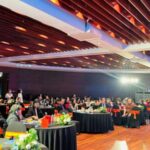Opinions at the conference underscore the value of connectivity, learning, and collaboration between cities; and the leverage of the Creative City designation in each locality, thereby making positive contributions to socio-economic development and improving the lives of residents.
The ASEAN’s UNESCO Creative Cities Network Conference in Hanoi is an event within the framework of the Hanoi Creative Design Week 2023. With the participation of over 100 delegates, and dignitaries, including more than 20 representatives from UNESCO Creative Cities and representatives from cities planning to submit applications to join the network in 2025 and the following years, the conference has garnered valuable insights into building Creative Cities for sustainable development and enhancing the quality of life for residents.

The conference attracted the participation of over 20 representatives from UNESCO Creative Cities.
The UNESCO Creative Cities Network was established in 2004 to promote international cooperation among globally recognized cities, using CULTURAL RESOURCES and CREATIVITY as the foundation for sustainable urban development. In 2019, Hanoi officially became a member of UNESCO’s Creative Cities Network (UCCN) with the designation as a Creative City in the field of Design. Hanoi is the first city in Vietnam to join the UNESCO Creative Cities Network and is also the first city to issue a dedicated resolution on the development of cultural industries.

Director of the Hanoi Department of Culture and Sports, Do Dinh Hong, delivered remarks at the conference.
Joining the UNESCO Creative Cities Network marks a significant stride for the capital city in positioning its brand and promoting its image across various creative cultural domains. It aligns with the global trend of innovation and is congruent with the United Nations 2030 Agenda for Sustainable Development.

Ms. Pham Thi Thanh Huong, Head of the Culture Department, UNESCO Office in Hanoi, also spoke at the conference.
After nearly four years of implementing initiatives to boost design in cultural, economic, and social development programs, despite challenges posed by the COVID-19 pandemic and urbanization issues, Hanoi has successfully fulfilled its commitments to UNESCO in the bid to join the network. This includes organizing eight seminars and international symposiums to consult on developing policies for Hanoi’s creative city status. The city has also established a network of young creative designers and consolidated creative spaces within its boundaries. Notably, Hanoi hosts the annual Creative Design Festival with themes like “Igniting Creativity” in 2021, “Innovation and Technology” in 2022, and 2023, “Flow” with a series of activities and events aimed at urban renewal, cultural creativity, and industrial heritage revitalization.

A representative from Thailand also addressed the conference.
Director Do Dinh Hong shared, “In fulfilling the commitments upon joining the Creative Cities Network, Hanoi has issued Plan No. 102/KH-UBND on April 1, 2022, outlining the implementation of initiatives participating in the UNESCO Creative Cities Network until 2025. Resolution No. 23/2022/NQ-HDND dated December 8, 2022, by the Municipal People’s Council specifies incentives and support for ‘People’s Artists,’ ‘Outstanding Artists,’ and exemplary artists and clubs in the intangible cultural heritage field of Hanoi. Additionally, Hanoi has implemented various initiatives to enhance the effectiveness of public pedestrian spaces, contributing to numerous creative cultural spaces and handicrafts within the city.”

A representative from Kuching City spoke at the conference.
According to Ms. Pham Thi Thanh Huong, Head of the Culture Department at the UNESCO Office in Hanoi, “With the addition of 55 new cities to the UCCN, the network now boasts the participation of 350 cities from over 100 countries. When joining the network, creative cities aim to establish and develop Innovation and Creativity Centers, opening up numerous creative spaces. The development of the creative city network relies on three main pillars: design, community, and innovation. It contributes to creating optimal conditions for young creators to unleash their potential, fostering good living spaces for urban residents, thereby improving their quality of life. Emphasis is placed on improving and attracting community participation in creative cultural activities, while also caring for and supporting vulnerable groups, such as people with disabilities, women, children, and the elderly. A Creative City is not the responsibility of a single unit; every sector needs to join hands and contribute to society to not only bring about sustainable development but also create products and services beneficial to society.”
Delegates representing creative cities in Singapore stated that Singapore has been recognized as a Creative City in the field of design since 2015. The city has established the Singapore Design Council and organized a series of community engagement activities, including Creative Design Week, Designer Forums, creative design districts, and design markets. These initiatives aim to affirm the crucial role of design in daily life, nurture design talents, and promote Singaporean design brands.
Representatives from Kobe (Japan), Kuching (Malaysia), Bangkok, Chiang Mai, Sukhothai, Phetchaburi (Thailand), and Bandung (Indonesia), among others, shared lessons on success and challenges in leveraging the effectiveness of creative city values. Despite differing starting points and geographical conditions, with each recognized as a Creative City and fulfilling commitments upon joining the Creative Cities Network, the opinions expressed at the conference unanimously emphasized the value of connection, learning, and collaboration between cities. The application of creativity in the fields of creative design, visual arts, fashion, music, heritage preservation, and value enhancement was highlighted in each location, depending on the characteristics and resources of each locality. This contributes positively to economic and social development, enhancing the lives of residents.
Additionally, experts and delegates exchanged ideas on how the Creative Cities Network in the ASEAN+3 region can leverage its cultural and creative resources in the context of urban challenges arising from rapid urbanization and climate change.

